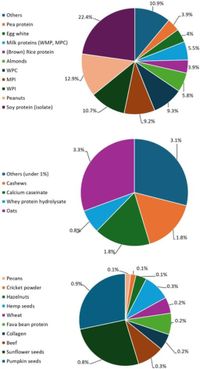Protein bars have become a staple in the diet of health-conscious consumers, boasting high levels of protein often marketed as ideal for boosting energy and muscle recovery. However, a recent study published on March 18, 2025, challenges the nutritional quality associated with these popular snack items, particularly focusing on how the source of protein affects digestibility and overall nutritional value.
Researchers evaluated 1,641 protein bars cataloged on OpenFoodFacts.org, discovering that 81% could be classified as 'high in protein,' meaning they contained more than 20% of their total energy derived from protein. Despite this classification, the actual digestibility values of these proteins varied significantly based on their formulation, with values ranging between 47% and 81%—lower than when the same proteins were evaluated in isolation.
The study categorized the protein sources of the bars into four distinct types: purely plant-based (pea and rice), purely animal-based (milk proteins), a mixture of animal and plant proteins, and bars containing collagen alongside other protein sources. Notably, whey protein isolate (WPI) and soybean protein emerged as the most commonly used ingredients, accounting for roughly 22% and 13% of the bars reviewed, respectively.
Among the findings, the highest Digestible Indispensable Amino Acid Score (DIAAS)—a measurement of protein nutritional quality—was recorded at 61 for a bar comprising solely animal protein sources. In contrast, the scores for other bars, especially those relying on plant proteins, were significantly lower. This insight prompts a critical assessment of the claims made on many protein bar labels, particularly as it pertains to consumer perceptions regarding health and protein content.
Interestingly, the nutritional analysis revealed distinct differences between animal and plant-based protein bars. Animal-based bars had higher protein and fiber content, while also containing lower levels of fat, carbohydrates, and sugars compared to their plant-based counterparts. This could suggest advantages for consumers seeking to maximize nutritional intake with minimal additional calories.
Moreover, protein bars that included collagen were noted to have higher overall protein contents, with estimates ranging from 35 to 50 grams per 100 grams. However, the study emphasizes the concept of bioaccessibility, indicating that the presence of various ingredients—particularly carbohydrates and fats—complicated the absorption of proteins and their associated amino acids.
Among the four specific protein bars subjected to in vitro digestibility testing, the bar consisting entirely of milk proteins demonstrated the highest digestibility percentage (85.9%). In comparison, the bar made from a mix of pea and rice proteins recorded a much lower figure at 46.7%, further underscoring the quality differences influenced by protein sources.
It was also observed that protein bars with mixed sources tended to achieve moderate digestibility results. However, these bars, despite significant protein claims, often fell short of the FAO-recommended threshold for nutritional quality, suggesting that high protein content alone does not equate to high-quality nutrition.
Finally, all four bars analyzed were eligible to carry the EU's 'high in protein' label. Still, according to FAO guidelines, such claims should be re-evaluated, as they indicate that bars with a DIAAS less than 75 should not promote high protein benefits. This casts doubt on the efficacy of labeling in guiding consumer choices effectively and suggests a dire need for more transparent nutritional assessments in product formulations.
The findings underscore an important message: while protein bars offer convenience and a quick energy boost, their actual nutritional quality can vary considerably based on their ingredients. The inclusion of a diverse range of sources in a high-protein snack could potentially dilute its overall effectiveness, indicating that consumers remain well-advised to consider protein bars as part of a balanced diet rather than a sole source of nutrition.




